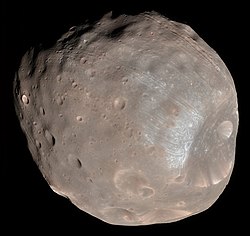
I think I bought this game based solely on the words "Scratch & Sniff" on the label. Well, that - or the three advertised playing modes (Tame, Suggestive and Lewd).
Posted on 03/13/2013 7:44:50 AM PDT by BenLurkin
On March 25, 2010, the European Space Agency (ESA) announced on their blog that ESA’s study of the mass of Phobos had been accepted for publication in the scientific journal Geophysical Research Letters. The announcement excerpted startling conclusions of ESA’s findings: “We conclude that the interior of Phobos likely contains large voids. When applied to various hypotheses bearing on the origin of Phobos, these results are inconsistent with the proposition that Phobos is a captured asteroid.” (1,2)
Since that time, a number of prominent ancient astronaut blogs have had plenty to say about the findings. The ESA findings were most recently written about in December of 2012.
It should be noted here that Russia also launched a second probe to Phobos on November 9, 2011, but the mission failed to escape Earth orbit and presumably fell to the sea. Most likely, chatter about the unsuccessful Russian Phobos-Grunt probe renewed interest in the ESA findings during 2012.
To date, internet speculation on Phobos has included: it’s a gigantic spaceship possibly built as an orbiting station or space observatory; a generation starship that arrived from another star system and was placed in parking orbit around Mars; it was being built in Mars orbit for interstellar travel but was never completed; and, it’s a functional (or non-functional) gargantuan planet-killing space bomb.
Although Phobos is referred to as a moon of Mars, its actual size is more like one of the larger asteroids located in the main asteroid belt between Mars and Jupiter. To give an example, the asteroid Gaspara is one of the larger main belt asteroids, coming in at 11km. Phobos is also 11km. To give further perspective, Earth’s Moon is 1,737km. So, Phobos is a moonlet of Mars at best.
(Excerpt) Read more at whofortedblog.com ...
That is nonsense. There are about 140 main-belt asteroids with diameters greater than 120 km.

I think I bought this game based solely on the words "Scratch & Sniff" on the label. Well, that - or the three advertised playing modes (Tame, Suggestive and Lewd).
The ice theory makes the massive craters hard to explain, doesn’t it.
Also, isn’t 11km diameter too small to explain a spherical form, unless its is comprised of gravel?
It’s an old Walmart.
Aww, I was hoping that there might be Dahak in there.
Phobos is hardly spherical, more like a peanut or potato


Phobos has dimensions of 27 × 22 × 18 km,[2] and is too small to be rounded under its own gravity. Its surface area is slightly less than the land area of Delaware. It is one of the least reflective bodies in the Solar System. Spectroscopically it appears to be similar to the D-type asteroids,[13] and is apparently of composition similar to carbonaceous chondrite material.[14] Phobos's density is too low to be solid rock, and it is known to have significant porosity.[15][16][17] These results led to the suggestion that Phobos might contain a substantial reservoir of ice. Spectral observations indicate that the surface regolith layer lacks hydration,[18][19] but ice below the regolith is not ruled out.[20][21]
I don’t see any tremendous conflict in either of those ideas. Much of the trick would have to do with the original comet, and where it picked up the rock, and if tidal forces around Jupiter were involved.
I now see that with other photos. Thanks.
"We conclude that the interior of Phobos likely contains large voids. When applied to various hypotheses bearing on the origin of Phobos, these results are inconsistent with the proposition that Phobos is a captured asteroid."[sighs] That makes no sense. It's a nonsequitur. Having voids and being a captured asteroid are unrelated.
|
New Theory: Catastrophe Created Mars’ Moons
space.com | 29 Jul 03 | Leonard David
Posted on 07/29/2003 8:56:47 AM PDT by RightWhale
http://www.freerepublic.com/focus/news/954539/posts
Astronomy Picture of the Day — Phobos: Doomed Moon of Mars
NASA | October 28, 2012 | (see photo credit)
Posted on 10/28/2012 11:59:25 AM PDT by SunkenCiv
http://www.freerepublic.com/focus/chat/2951548/posts
The Shadow of Phobos:
First Indirect View of Martian Solar Eclipse Published in 1999
APOD | September 17, 2012 | Staff
Posted on 09/16/2012 5:13:52 PM PDT by lbryce
http://www.freerepublic.com/focus/chat/2932081/posts
some more fruity stuff:
Armchair astronaut discovers Mars ‘space station’ using Google earth
dailymail.co.uk ^ | June 4, 2011
Posted on 06/04/2011 6:05:41 PM PDT by Free ThinkerNY
http://www.freerepublic.com/focus/chat/2729996/posts
this is the one I was looking for, legit, but with some more “Phobos is artificial” material:
Astronomy Picture of the Day — Stickney Crater
NASA | January 18, 2013 | (see photo credit)
Posted on 01/18/2013 3:13:45 PM PST by SunkenCiv
http://www.freerepublic.com/focus/chat/2979636/posts
Dang it, we are doomed unless they self destruct first.
Greg Bear has a excellent award wining book called Eon? about a hollow rock like this parking itself in orbit.

Disclaimer: Opinions posted on Free Republic are those of the individual posters and do not necessarily represent the opinion of Free Republic or its management. All materials posted herein are protected by copyright law and the exemption for fair use of copyrighted works.